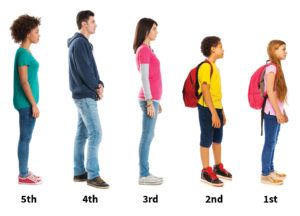
What Are Numbers?
Numbers are used to describe quantities of all kinds and the order of things, like:
- Exactly how many (“I have 4 books”) or how much (“That’s 2 teaspoonfuls of sugar”)
- Approximately how many (about 20 people) or how much (almost one cup of water)
- Parts of things (6 pieces of the puzzle) or proportions (one-half of the apple)
- The order of things (grocery store aisles) or the sequence of events (“First, put on your socks. Second, put on your shoes.”)
Why Is Learning About Numbers Important?
Numbers help us compare, measure, count, add or subtract, put things in order, and solve problems of all kinds. When children start kindergarten, their number knowledge helps prepare them to learn math. Children and adults use numbers every day in their work and play.
What Do Children Need to Know About Numbers?
Children need to learn:
- The correct sequence of number words
- The names for numerals, like 4, 5, 6
- That a number tells us “how many,” and later, that each number word means a specific quantity
- How numbers are related to each other
To support children’s numbers learning, adults need to know that:
- Number learning is gradual.
- Number words can be confusing to children because numbers are used in many different ways. A child hears the word “five” when adults say, “1, 2, 3, 4, 5…,” “José is 5 years old,” “Our address is 5 Maple Drive,” and more!
- It is difficult for children to understand numbers that refer to abstract ideas like time.
How Can We Help Children Learn Numbers?
Talk About Numbers Throughout the Day
- Use number words like three and fifteen, and name digits like 2 and 8
- Use words that describe quantity (many, few, dozen), or the relation between numbers (more than, less than, what comes next?)
Ideas for Exploring Numbers During:
Centers/Small Groups
Zookeepers: Count the items in one set of objects, then count the items in another set and compare the quantities of each set. Repeat with another pair of sets.
Guided Small Groups
Magician’s Tricks: Place numeral cards face down and in order. Children use the magic of counting to figure out what number is on a specific card.
Math Moments
Line Up by Number: Give each child a card with a numeral or set of dots; children use the card to line up in order.
How Can We Support Learning About Numbers at Home?
Encourage families to:
- Be number detectives by finding numbers in:
- Nature: “How many spots does the ladybug have?”
- Their neighborhood: “The stop sign has eight sides.” “How far is the bus stop?”
- Their home while cooking, cleaning, and playing
- Books, pointing out how many items are in the pictures
- Help children learn number words like 1, 2, 3, and words and phrases like some, a lot, a few, most.
- Count and compare: Count aloud instead of silently when children are near. Count the number of stairs they climb, bus stops they pass, and forks needed to set the table.
- Use number words to talk about order: For example, “This is the third book we are reading” and “We were second in line but now we are first.”
